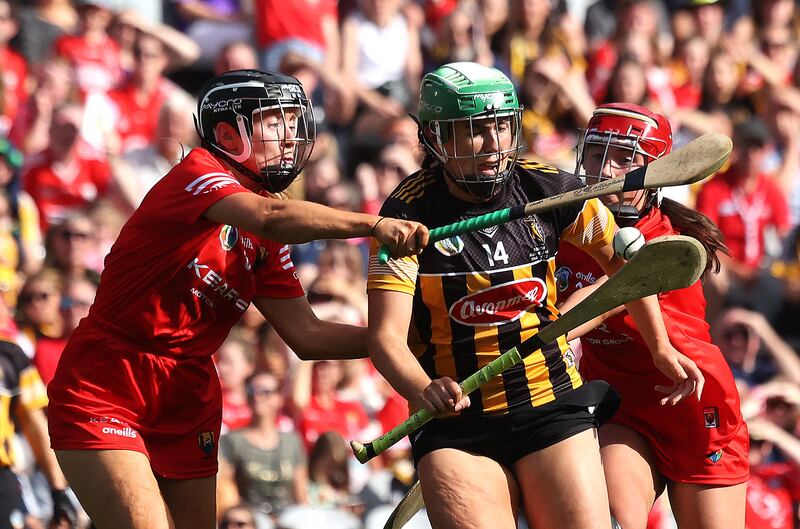–The old saying about only being as good as your last game somewhat rings true for camogie and camogie fans this year. The finals at Croke Park over the weekend were something to behold.
As a football-’til-I-die sort of girl, it pains me to say it. I like and admire camogie, absolutely, but the big ball game just captures my heart more.
Anyway, the senior final. It was a proper Cork and Kilkenny showdown. With Kilkenny hunting and defending in packs while Cork had a sweeper and played through the lines quickly, it really was a throwback to the early 2000s Cork v Kilkenny hurling deciders.
Of course, women’s sport does ask to be looked at differently, but this was one of the rare occasions the difference between men and women was non-existent.
READ MORE
Miriam Walsh and Denise Gaule were impressive for Kilkenny, while Fiona Keating, Saoirse McCarthy and Katriona Mackey were all on song for Cork, who struggled to score for the opening 20 minutes, not exactly an ideal thing to do in an All-Ireland final against your long-time rivals.
But one thing stood out for Kilkenny. Excuse the ‘millennial bro’ coaching manual, but the unity Kilkenny had was second to none.
Before and after the game, both players and Brian Dowling spoke very openly about the tragedies faced by this Kilkenny team and how, while understanding camogie isn’t everything, camogie actually brought them together and was a welcome distraction for all involved.
From a Cork perspective, the collaborative effort from Matthew Twomey and Davy Fitzgerald oddly worked. The defensive set-up with the sweeper oozed Davy, while the physicality, power, pace and putting the opposition on the back foot had Twomey’s fingerprints all over it.
Added to that, the ability to use camogie’s new adopted refereeing style of allowing tackles made it a far more exciting game. Ray Kelly, who also refereed the semi-final between Cork and Galway, deserves plaudits for letting both games go and not turning it into a free-taking contest.
In fact, the Camogie Association deserves praise for being proactive on the rules. If we’re to take anything from the Camogie Association, it’s that non-contact doesn’t really exist if definitions are muddled.
If the LGFA are to learn a thing or two from their associates in camogie, it’s how to embrace the soaring levels of strength, conditioning and fitness and allow girls to use the tackle as a skill.
There were so few front charging tackles in camogie, and as a result, the game flowed, defences were able to swarm better and forwards weren’t being punished for trying to penetrate defensive blankets.
This is what makes games exciting and this is what gets crowds going. And while camogie hasn’t gained the attention of sponsors or the sizeable crowds of their women’s football counterparts, what they have done is bridged the gap between their male counterparts on the pitch.
While that wouldn’t surprise those who regularly watch camogie, for those who tune in on their biggest day of the year, it actually entices people to come back.

This definitely does feel like a turning point for camogie. Maybe it’s because of the post Euros feelgood factor, but this final was an essential step in bridging the gap between camogie and ladies football.
Perhaps the same old Cork and Kilkenny rivalry got boring, but teams must be invested in to help them actually step up to the standard. In fact, the last 10 finals have featured some combination of Cork, Kilkenny and Galway.
Sure it’s old news, and a new team would spice things up, but the game at the weekend was something I hadn’t seen before between ladies football and camogie. An allowance for physicality and tackling. Understanding players won’t combust if tackled. Excitement over what women’s bodies can do without being confined by gender stereotypes and old-fashioned rules.
Camogie has an incredible opportunity to potentially catch up to ladies football. If that standard can be maintained, it will leapfrog ladies football, no problem, if the latter remains stagnant and dogged in its obsession with non-contact.
For the first time watching women’s sports, you got that sense of an old firm-style rivalry that left you with that bitter taste in the end. Of course I was happy for Kilkenny in the sense of having interviewed and come across some of their players in the line of work but, as a Cork woman, I still had that sense of `ugh, Kilkenny again’.
Call me old-fashioned, but when I get into a sport, I cheer for those I like and hope for the demise of my rivals. Camogie has the angle now. In fact, the ball is literally in their hands. What they choose to do with it is entirely up to them, but this really feels like the potential is there.















